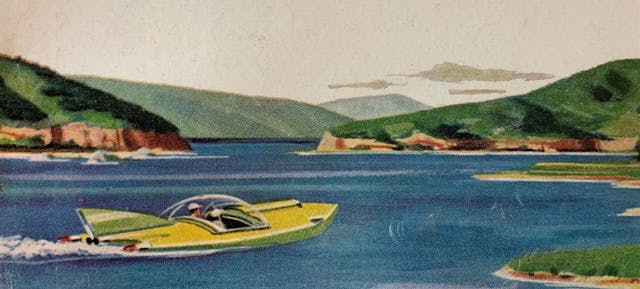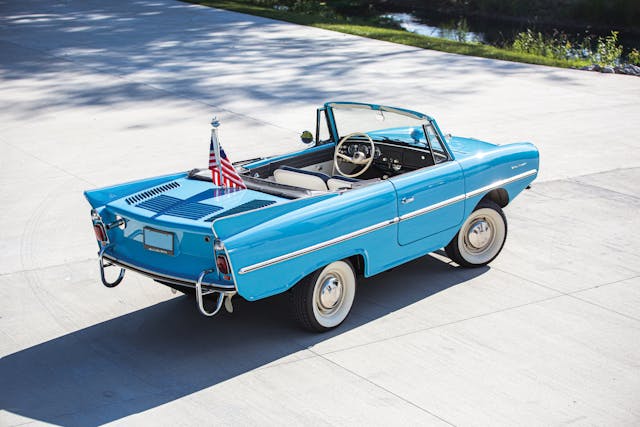3 years before the Amphicar, Americans dreamed of Automoboats

Before the Amphicar, there was the Automoboat. A conceptual design based on the knowledge that at least two American companies were working on the creation of “a practical, efficient car-boat,” Mechanix Illustrated introduced its own version of what the land-nautical vehicle might look like in its April 1957 edition. That was 65 years ago—and four years before Germany’s Quandt Group unveiled the Amphicar Model 770 at the 1961 New York Auto Show.
“Someday in the near future, a long, sleek car with a bubble canopy will drive down to the water’s edge and then splash right in,” the cover story begins. “Once afloat, its wheels will retract, and the driver, shifting from gears to a jet thrust, will become coxswain of a speedy family cruiser.”
Referring to the vehicle as the Automoboat on the cover but never referring to it as such in the story, Mechanix Illustrated writer Robert G. Beason continues: “This strange new vehicle will be the car-boat. Propelled by a gasoline turbine engine, it will skim over highways at better than 90 mph and reach a top pace afloat of nearly 50 mph. The cabin will serve up air-conditioned comfort for its passengers and offer riding ease of today’s luxury cars.”

The images of the new Automoboat are illustrated and signed by artist R. Brillhart, but no other credit is given. Considering that the boat-car looks more like a spaceship than a watercraft—is that George Jetson in the cockpit?—we assume that “R. Brillhart” is Ralph Brillhart, a commercial artist who painted a number of science-fiction book covers for New York publishers during the 1960s.
The story isn’t heavy on details, but there’s enough there to back up the legitimacy of such a commercial endeavor. And Mechanic Illustrated writer Beason leaves no doubt where he stands on the subject, saying the amphibious car’s arrival “now appears imminent.”
He writes: “This split-personality cruiser has never quite made the grade to date because of a multitude of engineering problems. They began with the power plant and extended into transmission and methods of power from wheels to prop. The need for good watertight shaft and grease seals complicated matters further.
“Several companies are experimenting with land-water buggies, and most major roadblocks have now been cleared away.” The magazine mentions Bassons Industries of Yonkers, New York, and Custom Hydrocraft of San Diego, which was working on a “prototype Hydromobile [that] has three retracting wheels, uses a standard auto engine, and has done 85 mph on land and 30 on water.”

Research uncovered no additional information on Custom Hydrocraft, but Bassons Industries is mentioned in author Marilyn E. Weigold’s 2014 book, Yonkers in the Twentieth Century. According to Weigold, in the mid-1950s Bassons Industries was “manufacturing a highly classified item for the U.S. Air Force … The company was also planning to mass produce a full-size plastic automobile it had displayed at an exhibition at the New York Coliseum.” Could that “plastic” have been fiberglass? And could that automobile have been a boat-car? Both are possible, but it’s difficult to know for sure.
Referring to fiberglass with a capital F and only one s, Beason writes: “In preparing its car-boat design, Mechanix Illustrated made the body molded Fiberglas for easy construction and repairs. Overall length is 20 feet and the beam measures 6 feet. A dual light system includes headlights for road driving and the red and green markers necessary for marine travel. Just aft the cabin is a radio aerial-flagstaff topped by a 360-degree white navigation light.
“A scoop on the bow furnishes fresh air to both cabin and engine, which is assessable through a hatch. Basic marine navigation instruments are mounted on the dash along with automotive gauges. Water-tight flaps close over the retracted wheels for streamlining, and pumps evacuate the water inside.”

Ultimately, the Automoboat never came to be. However, the German Amphicar became a reality in the 1960s and found enough interested buyers to support a production run of 3878 Model 770s. The Amphicar was smaller than the proposed Automoboat—14.25 feet long by 5 feet wide—and its 1147-cc four-cylinder engine wasn’t as powerful as Mechanic Illustrated’s Beason imagined such a vehicle could be. In the end, the Amphicar managed speeds of only 7 knots in the water and 70 mph on land, and history has relegated it to novelty status … albeit really cool novelty status.
Sixty-five years ago, however, Beason was still dreaming about the Automoboat. “The car-boat makes a luxury sports car, or it can carry the family to the beach, take them for a spin on the bay, and then return them home via the highway. You can troll from its deck, and you never need worry about a ferry. You have your own with you!” Or not.

